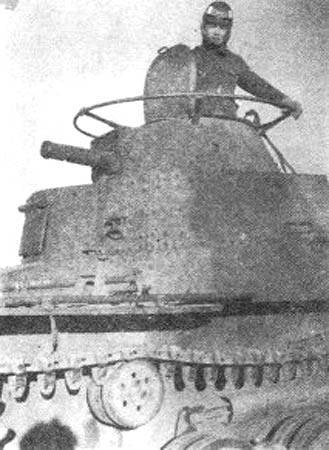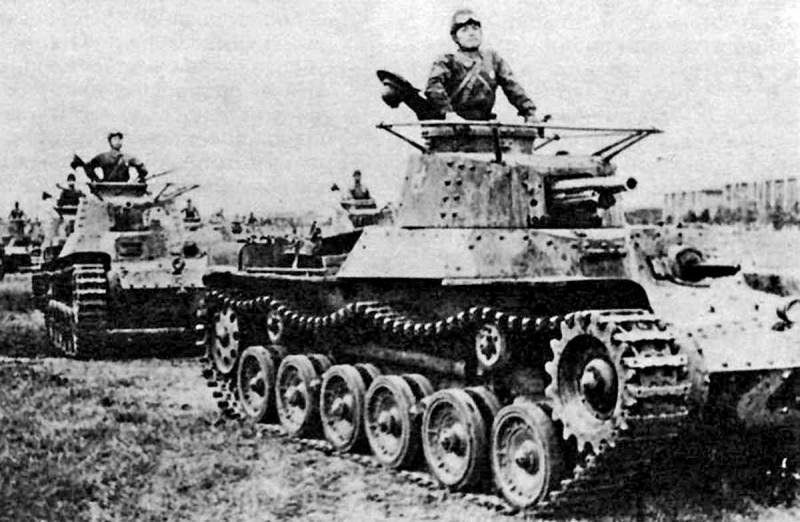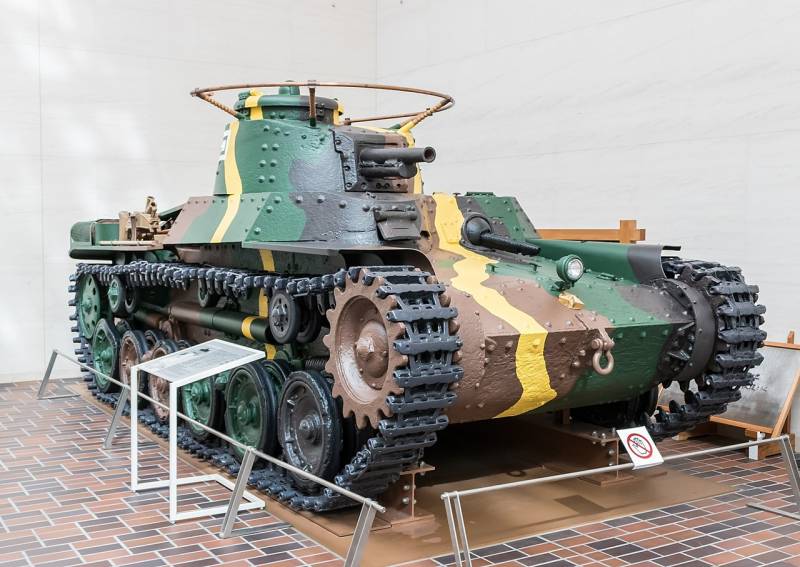Project "Ka-Ha": how the Japanese created a tank, killing an electric shock
By the beginning of World War II, all leading armies managed to put into operation a variety of electrical systems. Electrification provided lighting facilities, communication, etc. Accordingly, the incapacitation of electrical communications could affect the combat effectiveness of the enemy. To solve such problems, a special Ka-Ha electric tank was developed in Japan.
Project "Ka-Na"
According to various sources, since the late twenties, Japanese scientists have explored the possibilities of the combat use of electricity. The aim of the Ka-Na project was to determine the real possibilities of current and the creation of real combat systems capable of hitting people, equipment, apparatus, etc.
First of all, empirically determined the features of the impact of various voltage on manpower and electrical appliances of the enemy. It turned out that most electrical systems can not withstand voltages of more than several hundred volts and simply burn out. Damage to the device can be accompanied by destruction and fire, potentially dangerous to others.
The fight against manpower turned out to be more complicated - it required equipment with improved characteristics, capable of launching current through the ground. To defeat soldiers in tropical conditions (high soil and heat humidity, which contributes to increased sweating), a voltage of the order of 2-3 kV was required. In normal climatic conditions, fighters in summer uniforms were struck at 5-10 kV. Finally, in a dry climate with a winter uniform, the required voltage increased to 10 kV.
Based on the results of these studies, requirements for future military equipment were determined. It was necessary to develop a mobile generator set capable of delivering 10 kV to the ground or enemy communications. Such a product could fight the enemy’s manpower or disrupt its connection, energy networks, etc.
Soon, the first prototype of a combat generator was created. The necessary equipment was mounted on a wheeled trolley. Such a base ruled out real combat use, but allowed to show the main capabilities and remove the characteristics. After working out the prototype on a light chassis, the design of a full-fledged combat vehicle began.
Tank Ka-Ha
At the end of the thirties, the Ka-Na program reached the stage of creating a full-fledged electric combat vehicle. We decided to build this sample based on the latest average tank Type 97, also known as Chi-Ha. Alteration of the base machine did not take much time, and soon a completely new technique appeared.

The electric tank was called "Ka-Ha" - short for "Electricity and Destruction." In some sources, the syllable “Ha” is interpreted as an indication of the base tank “Medium, third”.
Unfortunately, the exact dates for the creation and construction of the Ka-Ha tanks are unknown. However, it is clear that this car could not have appeared before 1938, when the base medium tank went into the series. In addition, according to some sources, by the beginning of the forties, the Japanese army already had several "Ka-Has".
Design features
The original project involved the restructuring of a serial medium tank into a special electric tank. Such works were not particularly difficult. When remodeling, “Type 97” retained almost all the main units, but lost some equipment. After that, the appearance and performance characteristics as a whole remained at the same level, but fundamentally new opportunities appeared.
The armored housing with bulletproof protection as a whole retained its design, but received a higher turret box. The staff tower remained in place. Aft left 12-cylinder diesel power 170 hp.; a mechanical transmission was placed in the nose. The chassis remains the same.
Electric tank "Ka-Ha" did not need armament linear armored vehicles. The standard 57-mm gun and 7,7-mm machine gun were removed from the tower. They also removed the machine gun in the front of the hull. A barrel mockup was placed in place of the cannon, which made it possible to maintain similarities with the serial medium tank and not attract too much enemy attention.
"Ka-Ha" was built on the basis of the commander tank "Type 97", as a result of which he received a radio station. The only known photo of such a machine depicts a tower with a handrail antenna.
The released volumes of the fighting compartment were used for the installation of a DC generator. The type and architecture of this product is unknown. There are no exact data on this subject, but, most likely, the installation received its own engine of the required power. The product could deliver voltages up to 10 kV.
The tank received power distribution means, cables for supplying voltage to the ground or connecting to enemy wires and other special equipment. It was also necessary to provide for the isolation of the units, preventing the defeat of their own crew.
To tankmen, including The electrical equipment operator relied on Type 88 protective kits. It was a fully enclosed suit made of thick rubberized fabric with a helmet and gloves. In such a suit, the operator could work with his own equipment or with enemy electrified barriers.
A new type of electric tank was intended to defeat enemy forces and electrical systems. When working on the battlefield, it was envisaged to enter a position with the subsequent installation of cables at the desired points. The electric current supplied to the ground was supposed to spread and hit the enemy. It was also proposed to break through to the enemy’s wires and connect cables to them.
It was assumed that 10 kilovolts would be able to disable or kill enemy soldiers in the trenches. High voltage should have ensured defeat through clothing or other insulators. Also, the tank could burn any electrical system. Moreover, such an effect on lighting, a telephone or a telegraph could lead to the defeat of people, to fires, etc. At the same time, to solve combat problems, the electric tank did not have to come into direct contact with the enemy.
Secrets of exploitation
According to well-known data, up to the beginning of the forties, the Japanese industry manufactured a small number of Ka-Ha tanks. How the production was carried out is unknown. Special tanks could be built from scratch or manufactured by rebuilding existing vehicles of the “Type 97”. The number of vehicles released is unknown, but it is obvious that it was small.
It is reliably known about the existence of four copies of "Ka-Ha." After construction, this equipment was handed over to the 27 separate engineering regiment. At that time, the unit was stationed in Manchuria and provided for the activities of other units.
What was the operation of four special tanks is unknown. There are no data on the use of such a technique against real targets. In addition, questions are raised by the choice of location. The region was not too developed in terms of communications, but there could also be work in it for an electric tank.
The service of the four tanks continued until the summer of 1945. After the start of the Red Army offensive, the Japanese military began to destroy secret military equipment in order to prevent it from falling into the hands of the enemy. During this period, the 27th Engineer Regiment carried out a whole operation to eliminate its materiel. The regiment dug a huge pit and placed about a hundred units of equipment and weapons, as well as 16 tons of explosives. Probably, the subsequent explosion destroyed all the built Ka-Ha tanks.
Overly original design
Available data allow us to evaluate the special Ka-Ha tank and draw some conclusions. First of all, it is necessary to note an interesting idea that underlies the project. Japanese experts not only understood the value of electricity, but also looked for ways to use it in combat. It should be noted that the Ka-Ha tank was not the only attempt to use current in battle. The Ka-Na program led to several other equally interesting projects.
The advantages of the Ka-Ha tank include the relative simplicity of production through the use of a ready-made base. In addition, it should be noted the confirmed possibility of defeating manpower and equipment. In theory, some targets could be destroyed even at a considerable distance. The tank could damage the infantry or signalmen. In the latter case, one combat vehicle could disrupt the operation of whole units, formations and associations.
However, Ka-Ha turned out to be a highly specialized model with characteristic problems. The main disadvantage can be considered the complexity of combat work according to established methods. Deploying an electric tank in position was quite difficult and could attract the attention of the enemy. In addition, for the effective defeat of the enemy required an excessively powerful electrical equipment, which gave additional risks.
The struggle with communications communications and energy supply was hampered by objective factors. So, the most important wire lines are located behind enemy lines, and getting to them can be extremely difficult. It is hard to imagine how such an operation could be carried out.
You can also note the redundancy of the very concept of a special tank to defeat fighters and equipment with electricity. Any tank, artillery, infantry, etc. can solve the same problems. The ability to shock people and burn equipment was a characteristic feature of the Ka-Ha tank, but it was not its principal advantage over other weapons.
All this explains why the promising specialized tank was built in an extremely small series and did not receive much distribution. The Japanese army quickly appreciated all its positive and negative features and made the right conclusion. A unique and interesting tank was not suitable for mass operation.
However, the tank was not forgotten and even became the subject of jokes. A couple of years ago, one of the specialized Internet resources published an article with "previously unknown" data on an electric tank. It was alleged that this machine received an “100 Type” electric cannon and could literally shoot lightnings at 300 megavolts. Several Ka-Has fought in Burma and destroyed a significant number of British tanks.
However, this data was published on April 1, and it was just a hoax. The real characteristics of the "Ka-Ha" were much more modest than the "April Fools", but nothing is known about the combat use of such equipment. However, because of this, a bold project does not become less interesting.


Information